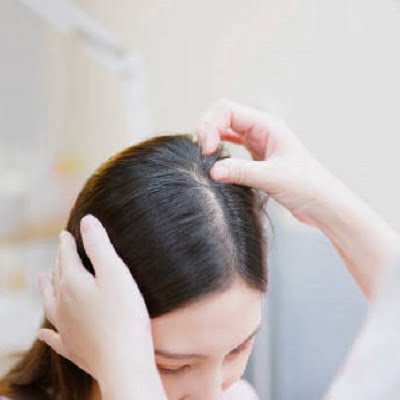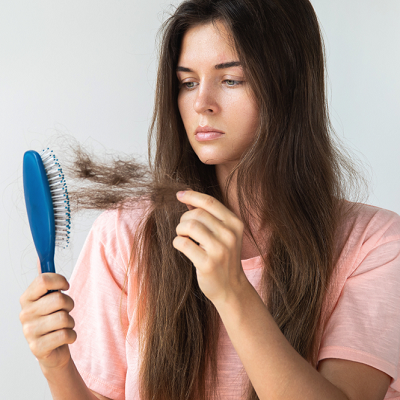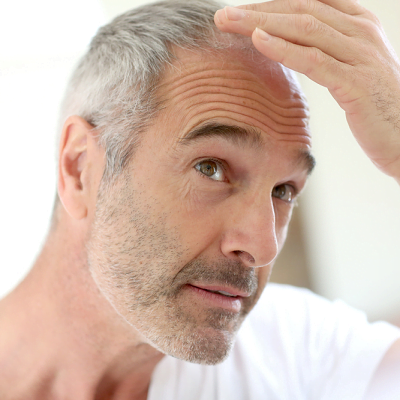
Hair loss in women is distressing and often puzzling because hair is every woman’s crowning glory. It is not only a significant issue in terms of appearance, but it affects the identity and quality of life of the people affected. One needs to comprehend the reasons for such matters, as the essence of the problem lies in the cause. There are various causes of excessive hair loss in women besides hormonal changes, stress, and illnesses or diseases.
Common causes of hair loss in women:
Female alopecia is not rare, and one must understand some common contributing factors to counter them correctly.
Genetics
Male and female pattern hair loss is inherited from the family genes and from the father or mother. This frequently causes baldness at the vertex of the scalp and the anterior midline by following a specific pattern.
Hormonal Changes
Hair loss can also result from hormonal changes during pregnancy, menopause, and menstrual cycles. As with many body processes, hormonal changes influence hair growth but cause shedding. Hypothyroidism and hyperthyroidism affect thyroid hormones and can lead to hair loss. Also, certain pills used to control births may affect hair routine.
Medical Conditions
There are situations where hair loss is prevalent in women, and there are causes attributable to it. Other such conditions include:
- Autoimmune alopecia areata.
- Reactions that spur the immune system to attack hair fibers.
- Hence causing hair loss.
Lifestyle factors and hair loss:
Male and female pattern baldness is thought to be mainly caused by hereditary factors; however, recent research has associated other aspects of everyday life with hair loss.
Stress and Anxiety
The hair also becomes vulnerable when stressed, and anxiety takes a toll on it. High-stress levels can lead to several issues with one’s hair; for example, the hair enters the telogen phase and can start shedding, leading to hair loss. Since tension contributes to hair loss, one needs to control stress through relaxation methods such as meditation, yoga, and deep breathing.
Hair Care Practices
The care practices on the hair also have implications for the overall findings. Extensions, using heated equipment, frequent dyeing, and having hair treated with chemicals also hurt the hair follicles, causing breakage and hair thinning. Caring for hair requires women to avoid straining hair with overwashing, harsh shampoos, heat styling, and tight hairstyles that pull hair.
Environmental Factors
Pollution, UV radiation, and other climatic factors also endanger hair health. Remember to wear hats or scarves in a polluted or sunny environment. Also, use hair products with sun protection because the sun can damage your hair, too.
Diagnostic Methods:
Medical Consultation
This is why consulting a doctor is essential when dealing with hair loss issues. Other experts, like dermatologists or endocrinologists, are involved in determining hair disorders and the subsequent administration of the appropriate treatment. In a consultation, the doctor will ask about medical history and the family history of the hair loss, feel the scalp’s surface, and examine the hair follicles.
Blood Tests and Biopsies
Medical tests, notably blood tests, are instrumental in determining the cause or causes behind hair loss. Some routine tests are hormonal profiling, thyroid profiling, and vitamin and mineral profiling. At times, scalp biopsy is the most suitable method to diagnose certain hair diseases or conditions.
Self-Assessment and Monitoring
Personal observation and evaluation should be used alongside medical analysis. Some valuable rules for hair loss care are Daily mapping of the hair loss and its pattern, changes in hair texture, and skin state of the head. Hair loss and premature hair loss, especially when accompanied by itching and inflammation, bald patches, and sudden or severe hair loss, should be treated by professionals.
Treatment Options:
Medications
Fountain-approved medications in combating baldness include Minoxidil, which is in the commercial market as Rogaine, and Finasteride, which goes by Propecia. Minoxidil is a solution used externally on the scalp, while finasteride is a tablet taken internally. Both treatments can effectively reduce hair loss and even encourage hair regrowth of hair, but they can also be unsafe and need a doctor’s attention.
Natural Remedies
Some of the natural cures include treatments such as essential oils for rosemary and peppermint and herbal supplements such as saw palmetto. Specific natural remedies for hair restoration have some potential, although their success is not steadfast, and research associated with them is not entirely concrete. Natural remedies should be used safely, and one must seek advice from a healthcare expert before incorporating them into the lifestyle.
Hair Restoration Procedures
Surgical procedures for hair loss are more permanent solutions when compared to other hair loss remedies. Hair transplant surgery is when hair follicles are moved from one part of the body, the donor area, to the bald or thinning area. But other methods of treating hair loss are also surgical such as laser treatment and PRP – platelet-rich plasma – treatment which also have a high degree of hair regrowth. Of course, every method has pros and cons, so before selecting this option, it is better to consult the doctor and consider the patient’s features.
Book a Consultation!
There is a chance of needing help from a specialist, even with the help of products such as medication, homeopathic products, and hair restoration techniques. Thus, at SKN Cosmetics, our professionals offer solutions to dyed hair issues and work with individuals’ unique approaches. Combined, we can have better, livelier hair.









